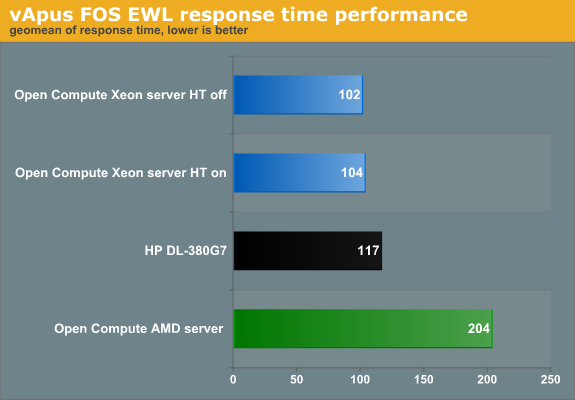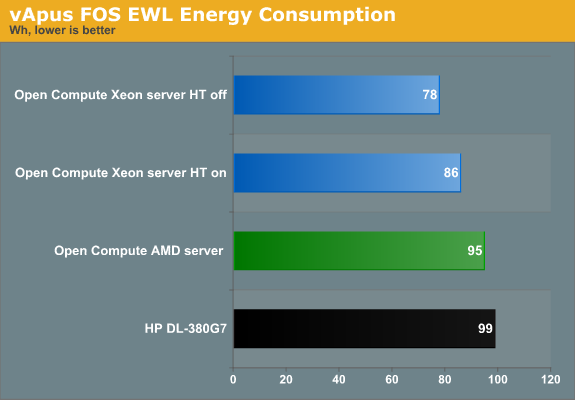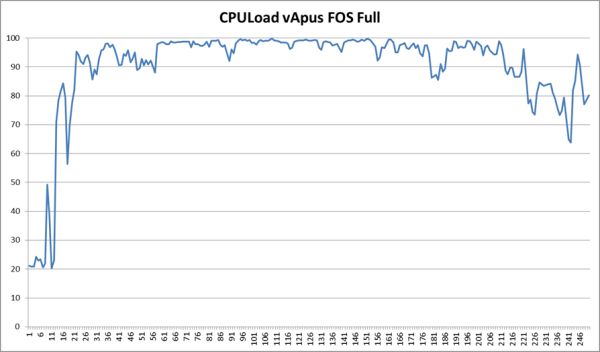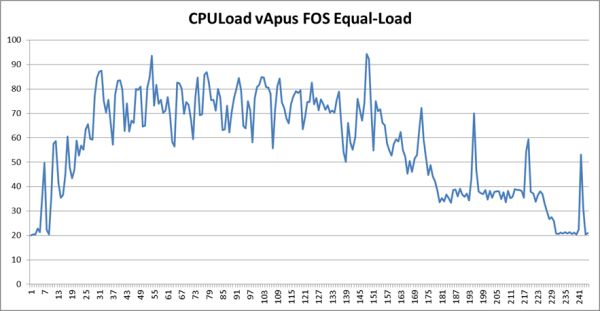Facebook's "Open Compute" Server tested
by Johan De Gelas on November 3, 2011 12:00 AM ESTMeasuring Real-world Power Consumption, Part 1
vApus FOS EWL
The Equal Workload (EWL) test is very similar to our previous vApus Mark II "Real-world Power" test. To create a real-world “equal workload” scenario, we throttle the number of users in each VM to a point where you typically get somewhere between 20% and 80% CPU load on a modern dual CPU server. This is the CPU load of vApus FOS:
Note that we do not measure performance in the "start up" phase and at the end of test.
Compare this with vApus FOS EWL:
In this case we measure until the very end. The amount of work to be done is always equal, and the faster the system, the sooner it can idle. The time of the test is always the same, and all tested systems will spend some time in idle. The faster the system, the faster the workload will be done and the more time will be spent at idle. For this test we do not measure power but energy (power x time) consumed.
The measured performance cannot be compared as in "system x is z% faster than system y", but it does give you an idea of how well the server handles the load and how quickly it will save energy by entering a low power state.

The Xeons are all in the same ballpark. The AMD system with its slower CPUs needs more time to deal with this workload. One interesting thing to note is that Hyper-Threading does not boost throughput. That is not very surprising, considering that the total CPU load is between 20 and 80%. What about response time?

Note that we do not simply take a geomean of the response times. All response times are compared to the reference values. Those percentages (Response time/reference Response time) are then geometrically averaged.
The reference values are measured on the HP DL380 G7 running a native CentOS 5.6 client. We run four tiles of seven vCPUs on top of each server. So the value 117 means that the VMs are on average 17% slower than on the native machine. The 17% higher response times are a result of the fact that when a VM demands two virtual Xeon CPUs, the hypervisor cannot always oblige. It has 24 logical CPUs available, and 28 (7 vCPUs x 4 tiles) are requested. In contrast, the software running on the native machine gets two real cores.
Back to our results. The response time of the AMD based server tells us that even under medium load, a faster CPU can help to reduce the response time, which is the most important performance parameter anyway. However, Hyper-Threading does not help under these circumstances.
Also note that the Open Compute server handles this kind of load slightly better than the HP. So while the Open Compute servers offer a slightly lower top performance, they are at their best in the most realistic benchmark scenarios: between 20% and 80% CPU load. Of course, performance per watt remains the most important metric:

When the CPU load is between 20 and 80%, which is realistic, the HP uses 15% more power. We can reduce the energy consumed by another 10% if we disable Hyper-Threading, which as noted does not improve performance in this scenario anyway.












67 Comments
View All Comments
iwod - Thursday, November 3, 2011 - link
And i am guessing Facebook has at least 10 times more then what is shown on that image.DanNeely - Thursday, November 3, 2011 - link
Hundreds or thousands of times more is more likely. FB's grown to the point of building its own data centers instead of leasing space in other peoples. Large data centers consume multiple megawatts of power. At ~100W/box, that's 5-10k servers per MW (depending on cooling costs); so that's tens of thousands of servers/data center and data centers scattered globally to minimize latency and traffic over longhaul trunks.pandemonium - Friday, November 4, 2011 - link
I'm so glad there are other people out there - other than myself - that sees the big picture of where these 'miniscule savings' goes. :)npp - Thursday, November 3, 2011 - link
What you're talking about is how efficient the power factor correction circuits of those PSUs are, and not how power efficient the units their self are... The title is a bit misleading.NCM - Thursday, November 3, 2011 - link
"Only" 10-20% power savings from the custom power distribution????When you've got thousands of these things in a building, consuming untold MW, you'd kill your own grandmother for half that savings. And water cooling doesn't save any energy at all—it's simply an expensive and more complicated way of moving heat from one place to another.
For those unfamiliar with it, 480 VAC three-phase is a widely used commercial/industrial voltage in USA power systems, yielding 277 VAC line-to-ground from each of its phases. I'd bet that even those light fixtures in the data center photo are also off-the-shelf 277V fluorescents of the kind typically used in manufacturing facilities with 480V power. So this isn't a custom power system in the larger sense (although the server level PSUs are custom) but rather some very creative leverage of existing practice.
Remember also that there's a double saving from reduced power losses: first from the electricity you don't have to buy, and then from the power you don't have to use for cooling those losses.
npp - Thursday, November 3, 2011 - link
I don't remember arguing that 10% power savings are minor :) Maybe you should've posted your thoughts as a regular post, and not a reply.JohanAnandtech - Thursday, November 3, 2011 - link
Good post but probably meant to be a reply to erwinerwinerwin ;-)NCM - Thursday, November 3, 2011 - link
Johan writes: "Good post but probably meant to be a reply to erwinerwinerwin ;-)"Exactly.
tiro_uspsss - Thursday, November 3, 2011 - link
Is it just me, or does placing the Xeons *right* next to each other seem like a bad idea in regards to heat dissipation? :-/I realise the aim is performance/watt but, ah, is there any advantage, power usage-wise, if you were to place the CPUs further apart?
JohanAnandtech - Thursday, November 3, 2011 - link
No. the most important rule is that the warm air of one heatsink should not enter the stream of cold air of the other. So placing them next to each other is the best way to do it, placing them serially the worst.Placing them further apart will not accomplish much IMHO. most of the heat is drawn away to the back of the server, the heatsinks do not get very hot. You also lower the airspeed between the heatsinks.